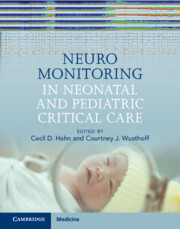Book contents
- Neuromonitoring in Neonatal and Pediatric Critical Care
- Reviews
- Neuromonitoring in Neonatal and Pediatric Critical Care
- Copyright page
- Contents
- Contributors
- Acknowledgements
- Part I General Considerations in Neuromonitoring
- Part II Practice of Neuromonitoring: Neonatal Intensive Care Unit
- Part III Practice of Neuromonitoring: Pediatric Intensive Care Unit
- Part IV Practice of Neuromonitoring: Cardiac Intensive Care Unit
- Chapter 13 Perioperative Monitoring for Congenital Heart Disease Surgery
- Chapter 14 EEG Monitoring in Neonates and Children Undergoing Extracorporeal Membrane Oxygenation
- Chapter 15 Neuromonitoring after Cardiac Arrest
- Part V Cases
- Index
- References
Chapter 14 - EEG Monitoring in Neonates and Children Undergoing Extracorporeal Membrane Oxygenation
from Part IV - Practice of Neuromonitoring: Cardiac Intensive Care Unit
Published online by Cambridge University Press: 08 September 2022
- Neuromonitoring in Neonatal and Pediatric Critical Care
- Reviews
- Neuromonitoring in Neonatal and Pediatric Critical Care
- Copyright page
- Contents
- Contributors
- Acknowledgements
- Part I General Considerations in Neuromonitoring
- Part II Practice of Neuromonitoring: Neonatal Intensive Care Unit
- Part III Practice of Neuromonitoring: Pediatric Intensive Care Unit
- Part IV Practice of Neuromonitoring: Cardiac Intensive Care Unit
- Chapter 13 Perioperative Monitoring for Congenital Heart Disease Surgery
- Chapter 14 EEG Monitoring in Neonates and Children Undergoing Extracorporeal Membrane Oxygenation
- Chapter 15 Neuromonitoring after Cardiac Arrest
- Part V Cases
- Index
- References
Summary
Extracorporeal membrane oxygenation (ECMO) is a temporary cardiopulmonary support for neonates and children with potentially reversible cardiopulmonary disorders. Patients requiring ECMO support are at risk for brain injury due to pre-ECMO medical conditions, ECMO cannula placement in the carotid artery and internal jugular vessels, and complications arising during ECMO. Acute brain injury may result in acute symptomatic seizures. Clinical and electrographic seizures are common in neonates and children undergoing ECMO. At the same time, the majority of seizures during ECMO are subclinical, and can only be diagnosed through continuous EEG monitoring. Thus, recent consensus statements have recommended increasing use of continuous EEG monitoring (cEEG) during ECMO in neonates and children. This chapter reviews the available data regarding seizure incidence, risk factors, and outcomes in neonates and children requiring ECMO support.
- Type
- Chapter
- Information
- Neuromonitoring in Neonatal and Pediatric Critical Care , pp. 181 - 188Publisher: Cambridge University PressPrint publication year: 2022

